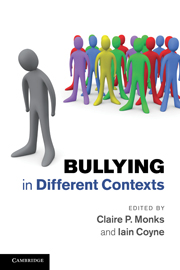Book contents
- Frontmatter
- Contents
- List of figures
- List of tables
- Notes on contributors
- 1 A history of research into bullying
- 2 Peer-victimisation in preschool
- 3 Bullying in schools: thirty years of research
- 4 Peer violence in residential children's homes: a unique experience
- 5 Domestic violence: bullying in the home
- 6 Juvenile dating and violence
- 7 Bullying in prisons: bringing research up to date
- 8 Bullying in the workplace
- 9 Elder abuse and bullying: exploring theoretical and empirical connections
- 10 Cyberbullying
- 11 An overview of bullying and abuse across settings
- Index
- References
2 - Peer-victimisation in preschool
Published online by Cambridge University Press: 05 June 2012
- Frontmatter
- Contents
- List of figures
- List of tables
- Notes on contributors
- 1 A history of research into bullying
- 2 Peer-victimisation in preschool
- 3 Bullying in schools: thirty years of research
- 4 Peer violence in residential children's homes: a unique experience
- 5 Domestic violence: bullying in the home
- 6 Juvenile dating and violence
- 7 Bullying in prisons: bringing research up to date
- 8 Bullying in the workplace
- 9 Elder abuse and bullying: exploring theoretical and empirical connections
- 10 Cyberbullying
- 11 An overview of bullying and abuse across settings
- Index
- References
Summary
There is an extensive body of research which has examined the bullying behaviours of schoolchildren during middle childhood and adolescence (see Smith, Chapter 3). Fewer studies have focused on children during preschool/kindergarten (between the ages of three and six years in most Western countries). Preschool settings may vary considerably within and between countries and attendance at preschool is not compulsory in most countries. However, according to UNICEF (2008), in developed countries, approximately 80 per cent of children in this age range spend some time in out-of-home child-care settings. Therefore, it is clearly important to explore the development of children's relationships with peers (including peer-victimisation) at this point.
The comparative lack of research with preschoolers is probably a reflection of the methods used to ask about bullying, which, in the main, have employed anonymous self-report questionnaires (e.g. the Olweus Bullying Questionnaire), and which are inappropriate for use with young children because of their more limited reading and writing skills. During the last decade, researchers have developed new methods of finding out about bullying and have begun to investigate these behaviours among younger children. Researching these behaviours among children during preschool/kindergarten (when their first peer-relations may develop) may provide insights into the ways in which peer-victimisation develops and provide us with methods of dealing with it early on, before it becomes an established part of a child's social repertoire.
- Type
- Chapter
- Information
- Bullying in Different Contexts , pp. 12 - 35Publisher: Cambridge University PressPrint publication year: 2011
References
- 9
- Cited by



